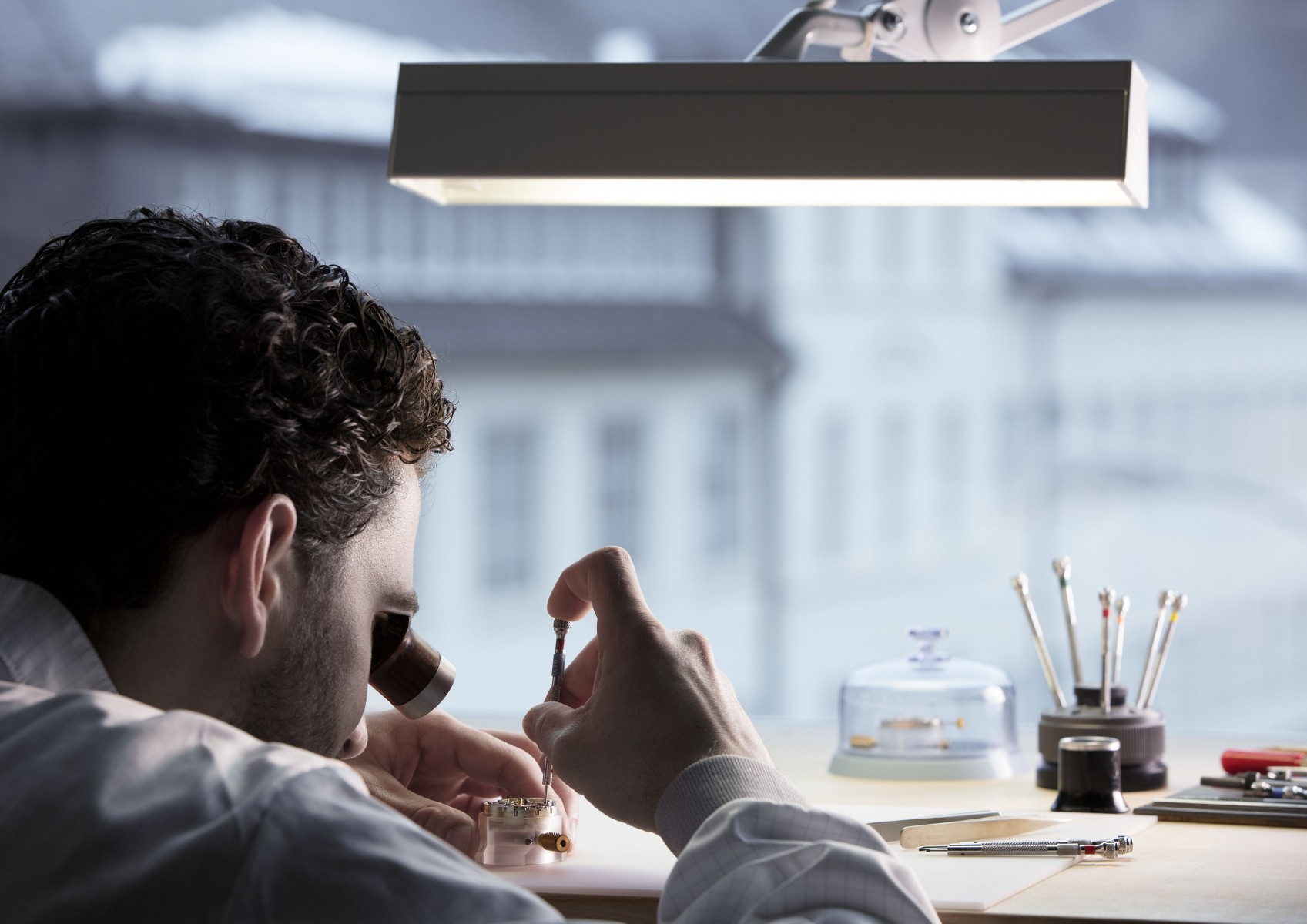Creation of a microcosm
Snapshots of the assembly of the TOURBOGRAPH PERPETUAL “Pour le Mérite”
At the Geneva Salon in January, A. Lange & Söhne presented the fifth watch with the appellation “Pour le Mérite”. It unites five complications and pays tribute to classic watchmaking as a paragon of true perfection. Given the numerous complex mechanisms, the assembly of the 684-part manufacture calibre is a formidable challenge. Only the best watchmakers can put together the individual subsystems with the precision required for them to interact flawlessly in the end.
“Substance over semblance” is the underlying motto of the Tourbograph Perpetual “Pour le Mérite”. Two of its five complications serve the sole purpose of improving rate accuracy. The fusée-and-chain mechanism ensures the smooth flow of torque from the mainspring barrel to the balance. Isolated from the influence of gravity, it oscillates inside the rotating tourbillon cage. The split-seconds chronograph is controlled in the classic manner with two column wheels. In a space-saving configuration, the module for the analogue perpetual calendar is built around the tourbillon.
The assembly of the movement is a venture of much greater complexity than meets the eye. “The harmonious interaction of the five complications does not even begin to do justice to the amount of work involved,” says Anthony de Haas, Director of Product Development at A. Lange & Söhne. In fact, no two assembly processes are alike. “Even if each of the 684 parts is manufactured strictly within the micrometre tolerance range, the watchmaker still has to perform many minute adjustments to ensure that all the mechanisms work together perfectly as envisaged by the calibre engineers,” de Haas muses. He adds: “On the part of the watchmakers, this calls for the utmost of technical comprehension, experience-based knowledge, manual virtuosity and virtually infinite patience.”
Crafting such a mechanical microcosm can only be entrusted to a small team of specialists who, over the course of the years, have honed their skills with sophisticated horological creations such as the Richard Lange Perpetual Calendar “Terraluna” and the Datograph Perpetual Tourbillon.
The following images capture a few decisive work steps out of several hundred:
Assembly of the fusée-and-chain mechanism
Once the watchmaker has wrapped the delicate chain around the previously assembled mainspring barrel, they can integrate both components into the basic movement. The chain is then attached to the fusée. The planetary gearing or differential must be mounted first. Inside the fusée, it ensures that the flow of power from the mainspring barrel to the escapement is not interrupted while the watch is being wound. The 38-part mechanism handles this function in a space with a diameter of merely 8.6 millimetres.
Using the ratchet wheel placed on the square barrel arbor, the watchmaker can adjust the final basic tension of the mainspring.
Assembly of the tourbillon
Assembling the tourbillon is one of the most difficult tasks in crafting the Tourbograph Perpetual “Pour le Mérite”. Before the filigreed component can be positioned in the basic movement, it will already have undergone a multitude of preparatory steps. The long road to perfection begins with the preliminary assembly of individual parts. Initial assembly is followed by adjustments, disassembly, final finissage and final assembly. The tourbillon bridge firmly secures the cage to the chronograph bridge as it rotates suspended between two diamond endstones. The newly introduced curved shape of the tourbillon bridge posed new challenges to the finishing specialists. The black-polish technique applied to the surface of the steel part is finished to a mirror gloss so immaculately that incident light is reflected in only one direction. The surface shines only when viewed from that angle. From all other perspectives, it appears to be jet black.
Assembly of the chronograph and rattrapante mechanism
The chronograph and rattrapante mechanism is located on the movement side. It consists of a total of 136 parts. During the assembly phase, all of the individual parts of the elaborate column-wheel ensemble are manually tweaked and adjusted. This is because the wheels, levers, arbors and springs involved in the complex switching sequences must interact in a precisely defined order within fractions of a second to prevent mechanical conflicts.
Assembly of the rattrapante wheel
The rattrapante hand arbor is about one centimetre long and extends from the dial to the rattrapante wheel on the opposite side of the movement. The arbor is turned from one piece of round hardened steel and painstakingly trued by hand. Then, it is passed through the hollow chronograph hand arbor.
Assembly of the rattrapante split-seconds clamp
Two column wheels control the chronograph functions. One of them deflects the arms of the rattrapante split-seconds clamp. The clamp is freely suspended so that its arms can centre themselves around the periphery of the rattrapante wheel, gripping it with uniform pressure from both sides. The surfaces of the clamp and the wheel are finished with straight and circular graining. The fine teeth of the wheel are roughened for a better grip.
Assembly of the perpetual calendar and the moon phase
The perpetual calendar correctly displays the different durations of the months in the 100-year cycle of the Gregorian calendar. In other words, it only needs to be corrected by one day in the year 2100. This is ensured by the 48-month wheel of the calendar module that has recesses and protrusions for each month.
The seven-stage transmission for the moon phases is calculated so precisely that it only needs a one-day correction after 122.6 years of uninterrupted operation. The deep blue hue of the white-gold lunar disc is the result of a patented coating process. Interference effects function like a filter that hides all non-blue colour spectra of the incident daylight. The crisply contoured stars are cut out of the coating with a laser beam.






